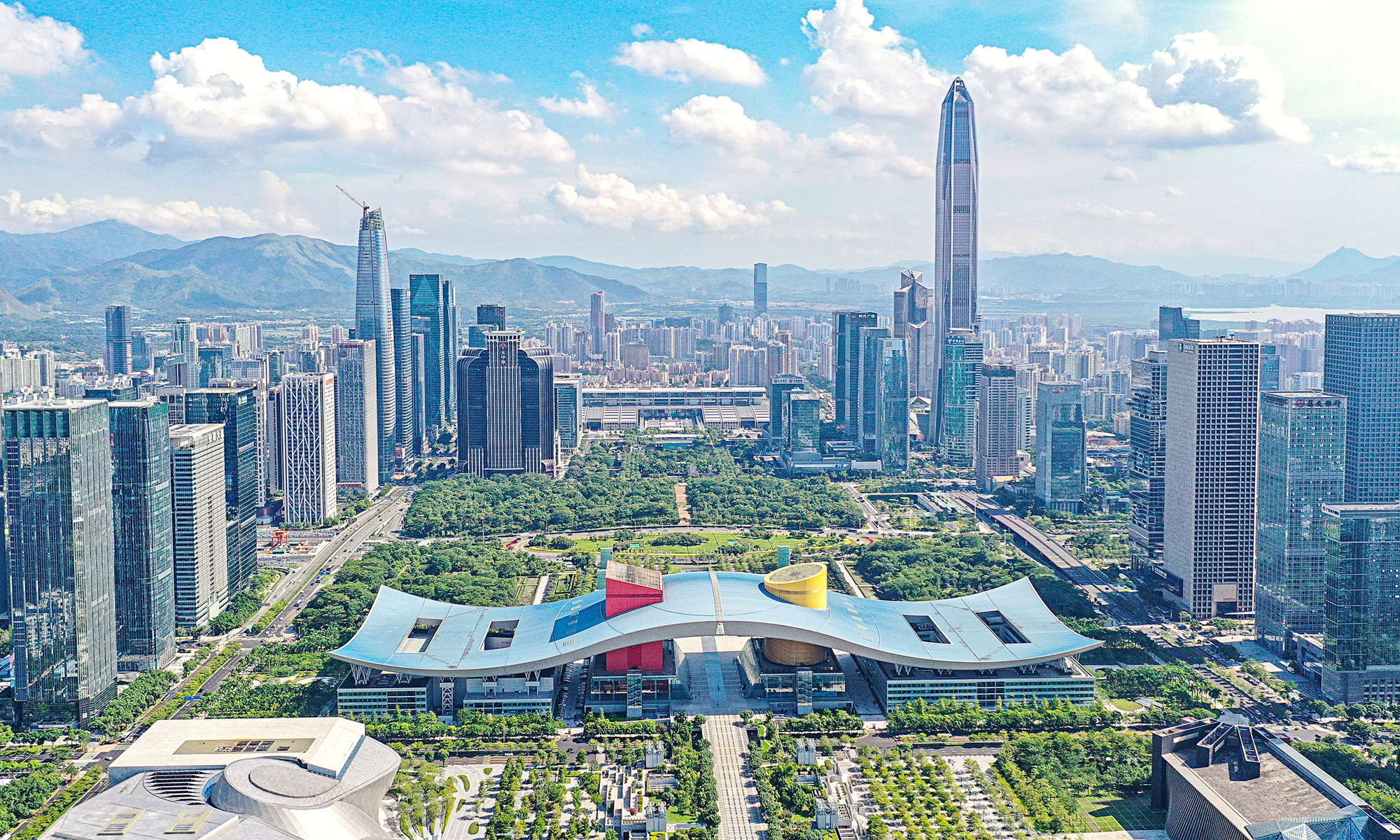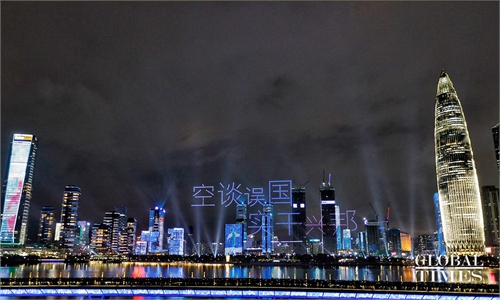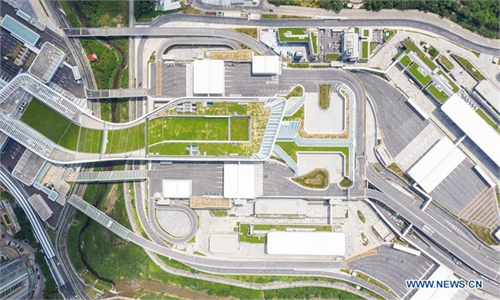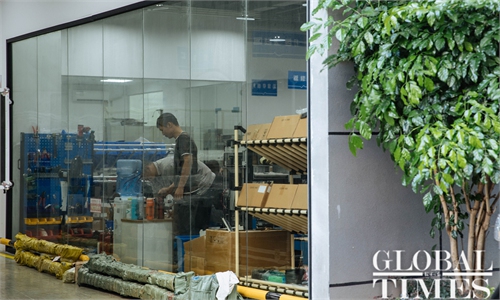Shenzhen becomes a tech powerhouse
City has access to talent, funds, and supply chains

Children play with a robot dog in Shenzhen, South China's Guangdong Province in August 2020. Photo: GT/Li Hao
It's lunchtime on Yue Hai Street in Shenzhen's Nanshan district, home to a number of big-name Chinese tech giants including Tencent, ZTE, DJI and Skyworth Group, as restaurants and coffee shops on Thursday were crowded and buzzing with tech employees, who sit around in groups, still debating the latest ideas and digital gadgets as they enjoyed their food.
But a discussion on international relations caught everyone's attention in one restaurant and was gathering pace.
"How should Chinese tech companies prepare for overseas expansion?"
"How should they launch litigations in foreign markets?"
The questions are coming one after another, and as the atmosphere grows more intense, it becomes clear the discussion won't end until it's time for everyone to return to work.
"We're now talking about broader issues," a spokesperson from Shenzhen-based drone-maker DJI surnamed Xie told the Global Times from a coffee shop on the street: "That's unlike before, where we just focused on the technology, and nothing else."
Xie notes that the trend emerged amidst the US' non-stop assault on Chinese tech firms, which has made virtually everyone on the street obsessed with legal issues and international politics.
Outside the coffee shop window, change is taking place all around - and not just as China's innovation hub transitions from day to night, but in the conversations, adaptations is being undertaken by tech companies in terms of sourcing and overseas plans.
On Thursday, one executive of a local TV-company told the Global Times on condition of anonymity that the firm had voluntarily frozen its business in the US over "geopolitical concerns." The company has also begun sourcing chips from South Korean and Japanese suppliers instead of from the US after Washington's selfish move to curb China's tech rise.
"We've endured many hardships in our years of development, and this time is no exception," the executive said. "Our confidence lies in how swiftly we are able to respond and in staying flexible."
A spokesperson from Shenzhen-based biotech giant BGI Group told the Global Times that the company has managed to "usher in dawn" after walking through darkness for a long time.
"In 2015, BGI released China's first homegrown key sequencing devices after years of research and development, shrugging of the monopoly of some foreign suppliers: a key turning point after which China's sequencing industry started to take off," the spokesperson said.
Being adaptable is just one of the foundations underpinning Shenzhen's rapid climb from being the world's low-end manufacturing factory to China's "Silicon Valley."
Shenzhen's special economic zone is embracing its 40th birthday this week. The city's innovations have only grown over time. It is now home to 14,400 national-level high-tech companies, with an industrial output valued at 2.6 trillion yuan ($378 billion).

Shenzhen. Photo: VCG
Years of striving pay offIn the eyes of many technology entrepreneurs, Shenzhen can be compared to the down-to-earth upstart, finally seizing opportunities after putting in years of work.
"Shenzhen's rise as China's high-tech hub came around 2010, when a wave of mobile internet trend arrived and the city pounced on its long-awaited opportunity to finally wear the crown," Xie said. "This didn't happen by accident, but because Shenzhen had spent two decades building a complete ecosystem that laid a solid foundation for churning out electronic products very efficiently."
"Is there any region in the world that can compete with Shenzhen and its neighboring regions in terms of the completeness of its supply chain?" asks Liu Tangzhi, CEO of Shenzhen-based Skyworth Group. "The answer is no."
For example, TV-maker Skyworth sources over 70 percent of its parts in the Pearl Delta River region, according to Liu.
The company started its business in Shenzhen in 1988 as an original equipment manufacturer for TV remote control devices. It's now grown into one of the world's leading TV-makers, with exports to Southeast Asia, Europe, the Middle East and Africa - providing a vivid example of how "quantitative change" can lead to "qualitative transformation" in Shenzhen over its 40 years of development.
Liu, who came to Shenzhen in 1998 after giving up a decent job at a state-owned enterprise in Guangzhou, said what impressed him most about the city was its tolerance of failure, enabling tech practitioners to try some "out-of-the-box" ideas without being criticized by others.
"Skyworth tried to launch into government office integrated systems and the smartphone business, but we failed due to the lack of foresight," Liu explained. "We didn't blame ourselves but instead were inspired to do better - that's just how Shenzhen as a whole approaches failure."
Li Junqi, chairman of Foxconn Industrial Internet Co, told the Global Times that the flexibility and resilience of Shenzhen's high-tech industries, combined with rich pool of talents and the city's solid foundation in tech ecosystem, will also bolster local companies' confidence in resisting external pressure and coping with uncertainties.
The role of Hong Kong
The proximity to Hong Kong, which is about a 30-minute ride by high-speed train, also gives Shenzhen an unprecedented edge in attracting international talent and gaining access to global capital.
Most of the foreign staff working at DJI are recruited and registered in Hong Kong. "Hong Kong plays a key role in bridging the talent gap between Shenzhen and the international market," Xie says.
Kris Tsang, a local HongKonger who founded co-working space firm "708090" in Shenzhen, told the Global Times on Thursday that Hong Kong was the perfect fundraising platform for a Shenzhen high-tech firm looking to align with their international peers.
Increasingly, Hong Kong tech start-ups are setting up branches in Shenzhen, eager to apply theoretical findings into market applications in Shenzhen and tap into the massive market in the Chinese mainland.
Li noted that Hong Kong's strength in economy will power the upgrade of Shenzhen's high-end manufacturing industry.
"The two cities will continue to support each other after going through profound changes," Tsang noted.





